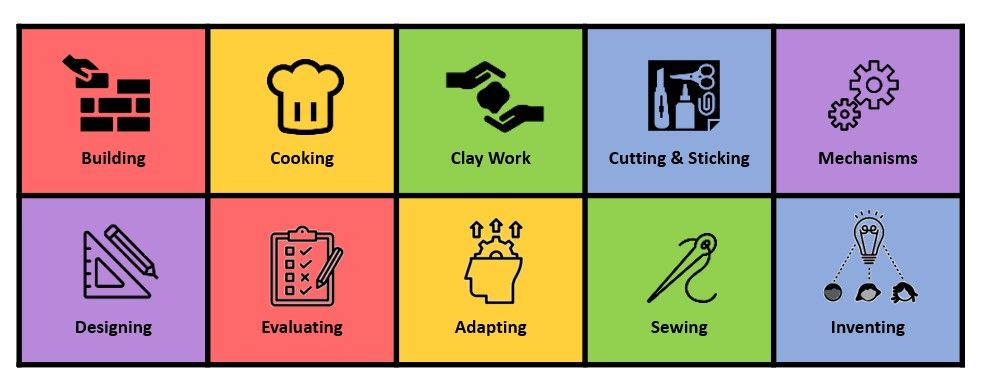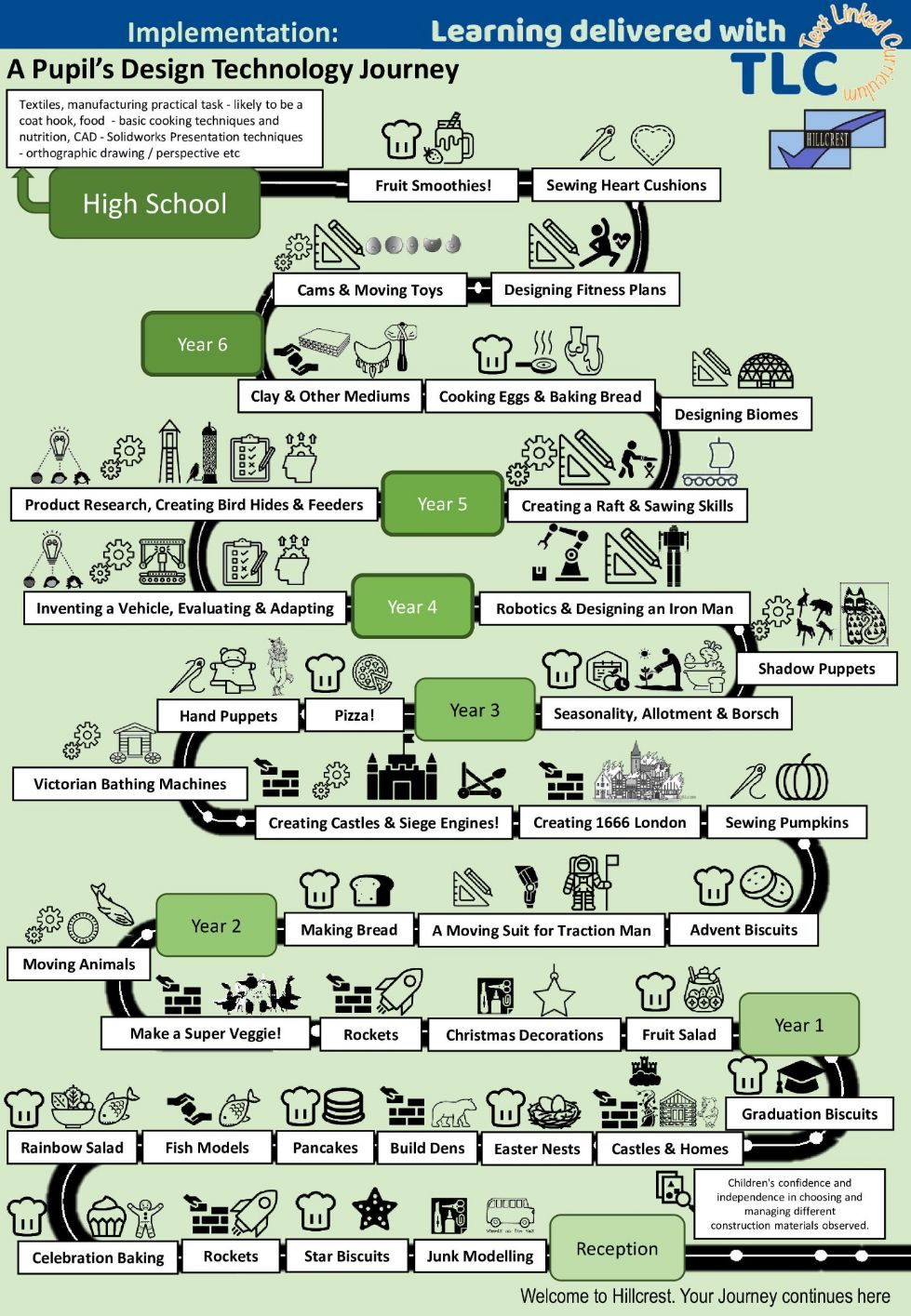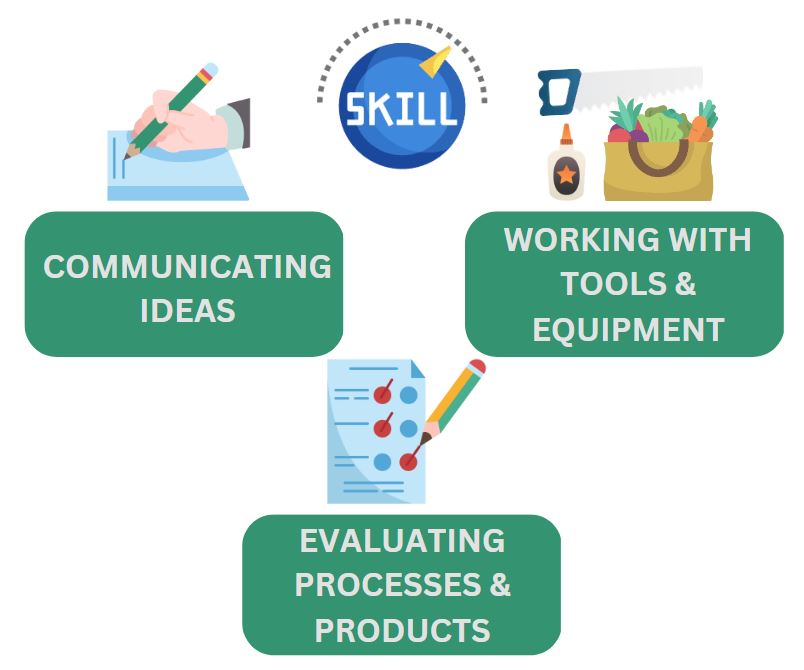Design Technology

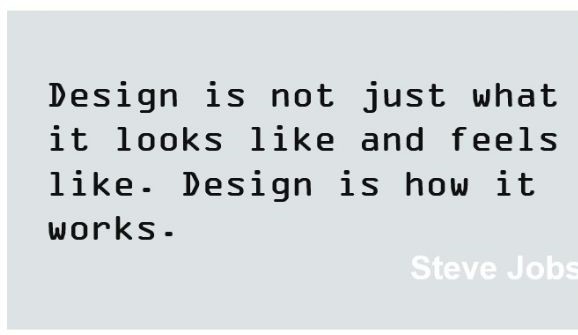
Hillcrest's 5 Principles of Design Technology
At Hillcrest, each subject team has created 5 key principles, outlining what makes up quality teaching in each subject:
|
|
|
|
|
|
|
|
|
Click on the INTENT, IMPLEMENTATION and IMPACT bars below to discover why and how we teach Design Technology.
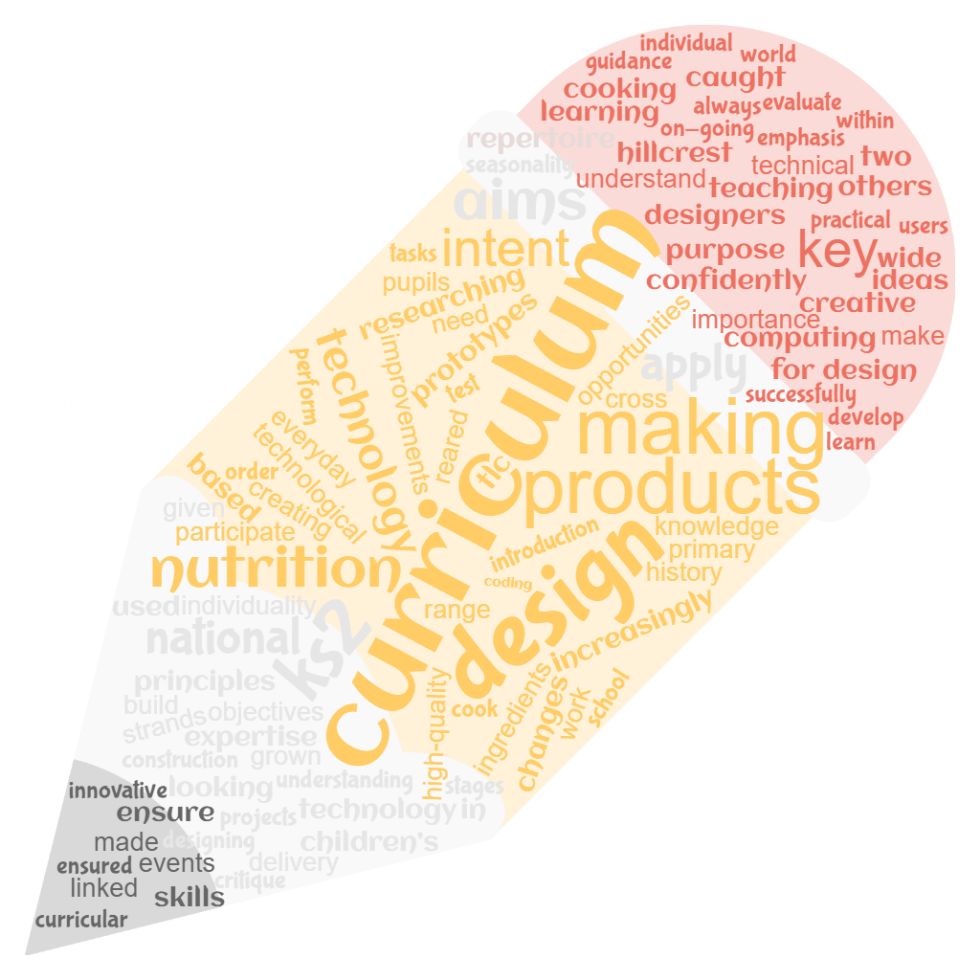
INTENT Statement for Design Technology
It is the intent of Hillcrest Primary School for Design Technology to be taught in all year groups. Design Technology projects are linked to our TLC curriculum and cross curricular learning opportunities are always used.
Key objectives of intent within the Design Technology Curriculum based on the National Curriculum 2014 guidance:
-
Products are to be made for a purpose.
-
Individuality should be ensured in children’s design and construction of products.
-
Delivery of the two strands: Designing and Making and Cooking and Nutrition.
-
More emphasis to be given on creating ‘innovative’ products in KS2.
-
Teaching the importance of making on-going changes and improvements during making stages.
-
Looking into seasonality of ingredients and how they are grown, caught or reared.
-
The introduction of computing and coding of products in KS2.
-
Researching key events and individual designers in the History of Technology in KS2.
We want our children to love Design and Technology. We want them to have no limits to what their ambitions are and grow up wanting to be architects, graphic designers, chefs or carpenters. Design and Technology is dynamic and multidimensional. It is our intention that our D&T curriculum will provide opportunities to solve real and relevant problems, allowing our pupils to develop essential everyday skills and unlock their potential to be the designers and innovators of tomorrow. The D&T curriculum will encourage children to learn, think and intervene creatively to solve problems both as an individual and as part of a team. Design and Technology will allow all Hillcrest pupils to put their learning from other areas of the curriculum into practise and will work to enhance and deepen their understanding of those areas, including Maths, Computing, Science, and Art. Hillcrest pupils will learn about cooking, food and nutrition, ensuring that they acquire the fundamental life skills in order to be able to feed themselves healthily and independently, whilst learning about where food comes from, therefore making connections with their geographical and scientific knowledge. We want to equip them with not only the minimum statutory requirements of the Design and Technology National Curriculum but to prepare them for the opportunities, responsibilities and experiences of later life.
Aims
The national curriculum for Design and Technology aims to ensure that all pupils:
-
develop the creative, technical and practical expertise need to perform everyday tasks confidently and to participate successfully in an increasingly technological world.
-
build and apply a repertoire of knowledge, understanding and skills in order to design and make high-quality prototypes and products for a wide range of users
-
critique, evaluate and test their ideas and products and the work of others
-
understand and apply the principles of nutrition and learn how to cook.
IMPLEMENTATION Statement for Design Technology
Children design products with a purpose in mind and an intended user of the products. Food technology is implemented across the school with children developing an understanding of where food comes from, the importance of a varied and healthy diet and how to prepare this.
Design and technology is a crucial part of school life and learning and it is for this reason that as a school we are dedicated to the teaching and delivery of a high quality Design and Technology curriculum; through well planned and resourced projects and experiences. STEM weeks during our school year allow children to experience hands-on learning and real-world applications, it develops life-long skills such as curiosity, critical thinking, problem-solving, creativity, communication and collaboration.
Design and Technology also embeds our 5C’s at Hillcrest, making curious, communicative, creative, coordinated and confident learners. It is an inspiring, rigorous and practical subject, requiring creativity, resourcefulness, and imagination. Pupils design and make products that solve real and relevant problems within a variety of contexts. It is very cross - curricular and draws upon subject knowledge and skills within Mathematics, Science, History, Computing and Art. Children learn to take risks, be reflective, innovative, enterprising and resilient. Through the evaluation of past and present technology they can reflect upon the impact of Design Technology on everyday life and the wider world.
Early Years Foundation Stage
During the EYFS pupils explore and use a variety of media and materials through a combination of child initiated and adult directed activities. They have the opportunities to learn to:
-
Use different media and materials to express their own ideas
-
Use what they have learnt about media and materials in original ways, thinking about form, function and purpose
-
Make plans and construct with a purpose in mind using a variety of resources
-
Develop skills to use simple tools and techniques appropriately, effectively and safely
-
Select appropriate resources for a product and adapt their work where necessary
-
Cook and prepare food adhering to good health and hygiene routines
National Curriculum requirements at Key Stage 1
Through a variety of creative and practical activities, pupils should be taught the knowledge, understanding and skills needed to engage in an iterative process of designing and making. They should work in a range of relevant contexts, (for example the home and school, gardens and playgrounds, the local community, industry and the wider environment).
When designing and making, pupils should be taught to:
Design
-
design purposeful, functional, appealing products for themselves and other users based on design criteria
-
generate, develop, model and communicate their ideas through talking, drawing, templates, mock-ups and, where appropriate, information and communication technology
Make
-
select from and use a range of tools and equipment to perform practical tasks, (or example, cutting, shaping, joining and finishing)
-
select from and use a wide range of materials and components, including construction materials, textiles and ingredients, according to their characteristics
Evaluate
-
explore and evaluate a range of existing products
-
evaluate their ideas and products against design criteria
Technical knowledge
-
build structures, exploring how they can be made stronger, stiffer and more stable
-
explore and use mechanisms, (for example levers, sliders, wheels and axles), in their products.
National Curriculum requirements for food and Nutrition at KS1
As part of their work with food, pupils should be taught how to cook and apply the principles of nutrition and healthy eating. Instilling a love of cooking in pupils will also open a door to one of the great expressions of human creativity. Learning how to cook is a crucial life skill that enables pupils to feed themselves and others affordably and well, now and in later life.
Pupils should be taught to:
• use the basic principles of a healthy and varied diet to prepare dishes
• understand where food comes from.
In Key Stage 2:
Within key stage 2 key events and individuals that have influenced the world of Design Technology are teaching focuses that are to be covered.
The use of computer programmes and applications are also a key focus to be utilised by children in their design of their products.
National Curriculum requirements at Key Stage 2
Through a variety of creative and practical activities, pupils should be taught the knowledge, understanding and skills needed to engage in an iterative process of designing and making. They should work in a range of relevant contexts, for example, the home, school, leisure, culture, enterprise, industry and the wider environment.
When designing and making, pupils should be taught to:
Design
• use research and develop design criteria to inform the design of innovative, functional, appealing products that are fit for purpose, aimed at particular individuals or groups
• generate, develop, model and communicate their ideas through discussion, annotated sketches, cross-sectional and exploded diagrams, prototypes, pattern pieces and computer-aided design
Make
• select from and use a wider range of tools and equipment to perform practical tasks, such as cutting, shaping, joining and finishing, accurately
• select from and use a wider range of materials and components, including construction materials, textiles and ingredients, according to their functional properties and aesthetic qualities
Evaluate
• investigate and analyse a range of existing products
• evaluate their ideas and products against their own design criteria and consider the views of others to improve their work
• understand how key events and individuals in design and technology have helped shape the world
Technical knowledge
• apply their understanding of how to strengthen, stiffen and reinforce more complex structures
• understand and use mechanical systems in their products, (for example as gears, pulleys, cams, levers and linkages)
• understand and use electrical systems in their products, (for example series circuits incorporating switches, bulbs, buzzers and motors)
• to apply their understanding of computing to programme, monitor and control their products.
National Curriculum requirements for food and nutrition at KS2
As part of their work with food, pupils should be taught how to cook and apply the principles of nutrition and healthy eating. Instilling a love of cooking in pupils will also open a door to one of the great expressions of human creativity. Learning how to cook is a crucial life skill that enables pupils to feed themselves and others affordably and well, now and in later life.
Pupils should be taught to:
• understand and apply the principles of a healthy and varied diet
• prepare and cook a variety of predominantly savoury dishes using a range of cooking techniques
• to understand seasonality, and know where and how a variety of ingredients are grown, reared, caught and processed.
IMPACT Statement for Design Technology
Design and Technology prepares children to deal with tomorrow’s rapidly changing world. It encourages children to become independent, creative problem solvers and thinkers as individuals and part of a team. It enables them to identify needs and opportunities and to respond to them by developing a range of ideas and by making products and systems. Through the study of Design and Technology, they combine practical skills with an understanding of aesthetic, social and environmental issues, as well as functions and industry. This allows them to reflect on and evaluate past and present technology, its uses and impacts.
Assessment of children's learning in Design Technology is an ongoing monitoring of children's understanding, knowledge and skills by the class teacher, throughout lessons and projects. This assessment is then used to inform differentiation, support and challenge required by the children.
Summative assessment is conducted termly by class teachers across each year group of the school to inform the subject leader of progress of skills and knowledge still to be embedded. This is recorded on Pupil Asset.
Design Technology is also monitored by the subject leader throughout the year in the form of book monitoring, looking at outcomes and pupil interviews to discuss their learning and understanding and establish the impact of the teaching taking place.
Explore the blue banners below to find out more about what specific themes we teach in Design Technology and how these themes are revisited, recalled and expanded upon as the children journey through the school.
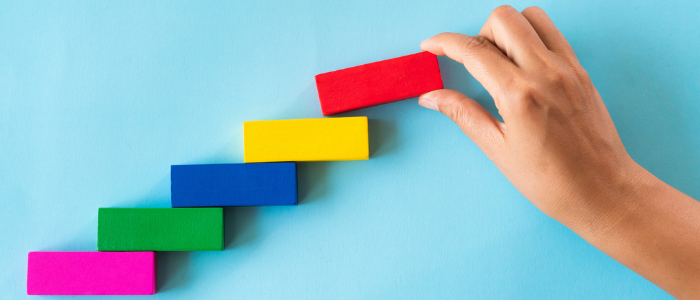
Year Group Overviews for Design Technology
COMING SOON
Progression for Design Technology
Learning Journey for Design Technology
Watch out for the following symbols in the Design Technology Learning Journey:
